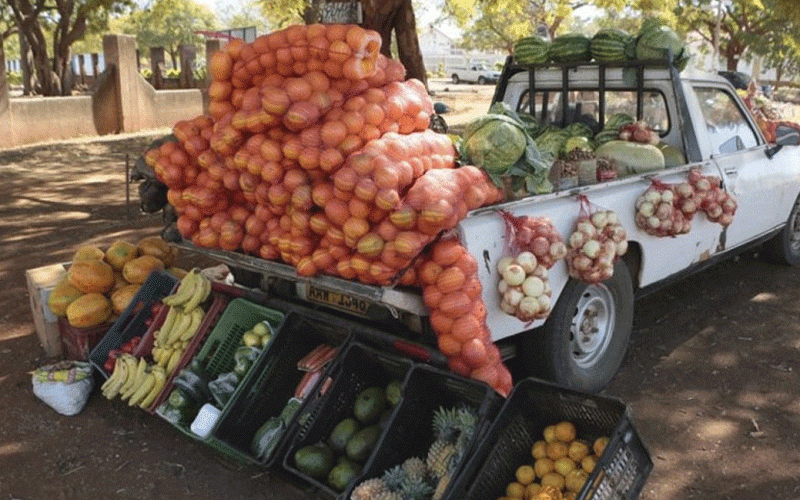
Everyone seems to be growing vegetables (and fruit) these days. It is big business and the horticulture sector is generating income, jobs and secondary businesses like never before. The ‘hidden middle’ in this value web is thriving.
In the past, the horticulture sector was divided between the large-scale commercial operations that, through the 1990s, had broken into international markets, selling vegetables and fruits to global markets in short time windows contracted by external buyers.
This required high phytosanitary and labour standards, such as through the GlobalGap system. This was lucrative business, but required much skill, lots of investment and very good networks. It was therefore dominated by white, large-scale farmers.
Alongside this business-oriented horticulture was the classic backyard gardening, usually the preserve of women to provide a few veg for relish, but with little expectation of significant sales beyond a few bunches of rape or kale or some tomatoes. Development projects from the 1980s onwards invested lots in ‘women’s gardening projects’ as their favoured livelihood intervention, often on a collective basis with a big diesel pump purchased to irrigate the area. Many of these failed as the cooperatives fell apart and the pumps were too expensive to repair.
All this changed following land reform. The large-scale, commercial horticulture sector took a knock as farms were redistributed, although some have persisted and maintained their markets.
Some farmers have even taken up joint ventures on A2 farms and are supplying export markets. Small-scale backyard gardening of course continues, but the big change has been the growth of horticulture farming across the country, particularly in the land reform areas. Plots range from 0.1 ha or less up to several hectares. These are intensive production areas, are usually irrigated and regularly employ multiple people, both permanently and casually.
This growth has been driven by a number of factors, most notably the increasing availability of (mostly) Chinese-built small-scale pumps.
This has allowed individuals to invest in irrigated horticulture for as little as US$200, buying a small pump and some piping to get going. Many have upgraded since to larger operations, buying solar equipment to power the pumps and increasing the horsepower of the pumps.
- Global demand buoys tobacco prices
- Edutainment: For Tsungie, a picture tells a story
- Edutainment: For Tsungie, a picture tells a story
- Zimbabwe students the biggest losers as new year begins
Keep Reading
Our study of the growth of small-scale irrigation in Masvingo found that across numerous small plots a huge amount was being produced across homestead, aspiring and commercial irrigators. In 2019, one commercial irrigator was securing an income of around US$30,000 from five hectares, with input expenses of US$12,000, and was employing some 20 people. Most aspiring irrigators had more intermediate operations, using a variety of pumping systems with plot sizes averaging 0.43 hectares. Extrapolating from this sample, the total output being generated by land reform areas in the province was huge.
So the new horticulture has intensified (through irrigation), diversified and specialised (into particular crops with secure markets) and commercialised (selling across multiple markets). We have been investigating this phenomenon over the past years (see here, here, here and here) and in recent weeks the team across our sites has conducted research to update this, in particular exploring the ‘hidden middle’ – the array of business activities that have sprung up around the boom in horticultural farming (following on from the earlier blog series on this theme on maize and poultry).
These new horticultural entrepreneurs make use of many different types of markets. Our research identified the following: municipal markets (in small towns and growth points, where fees are paid to the local authority); informal bakosi bush markets (occasional markets outside towns in rural areas, often involving hundreds of traders); supermarkets (OK, Pick and Pay and so on, where producers make a link to sell regularly); hotels, restaurants and informal food sellers (where contracts are struck for regular supplies; schools, hospitals, colleges, churches (again where contracts provide a clear market, including around big church events); road-side vendors (of which there are many, who may be the producer or may buy from producers) and mobile markets (often in the back of cars or pickups) that sprung up during the pandemic to avoid the police, but have persisted.
Together these markets make up a huge demand for horticultural produce. But the demand is differentiated. The standard, regular demand for green vegetables (covo/rape), onions and tomatoes is well serviced and sometimes results in gluts due to over-supply, but there is an increasing demand for specialist vegetables – such as butternut squashes and so on. Some crops have high value in wider markets (including export) and contractors may come and make deals with producers. In our sites in Chikombedzi, for example, contracted garlic and chilli growing takes place, while in Mvurwi, linking to major production on Forrester Farm, there are contracts for peas and beans.
Business opportunities
All this activity gives rise to many business opportunities. Most are small, informal businesses, with limited capitalisation, but they all generate employment for people based particularly in small towns near the horticulture production sites. Every small town has a number of new businesses that have emerged directly as a result of linkages with the growth in farm production, particularly after land reform. This is the ‘hidden middle’ of the post-land reform rural economic scenario.
The following activities within this ‘hidden middle’ have been identified during the research (in no particular order):
Transport — Moving perishable crops to markets is essential and the investment in one tonne trucks has been massive. Sometimes farmers buy them to transport their own crops, in other cases transporters ferry crops from a number of farmers. Motorbikes, donkey carts, push carts and every other form of transport are used to ferry crops to markets and collection points in a timely way.
Borehole drilling companies and well digging — While many new horticulture farmers have made use of small dams, ponds and rivers to irrigate from, this is not always possible. Others prefer to have their valuable horticulture produce nearer the home and this means getting new water supplies. Borehole drilling companies have sprung up everywhere. They offer a simple service including a survey and some test drills using a basic rig. If water is found they can drill and install a borehole with a pump. More traditional well diggers (using spades and dynamite) are also always in demand and many, many wells have been dug since land reform to irrigate areas.
Irrigation equipment suppliers — In many towns these days agricultural supplies shop stock basic pumps and plastic piping. These range from the low-cost units that have become so popular to more powerful versions. These days, with the declining costs of solar panels, solar installations for pumping are now available at reasonable costs. A vital bit of equipment, seen gracing so many homes these days, is the JoJo water storage tank. These too are supplied by dealers in most towns.
Artisans — All this new equipment requires servicing and repair. Unlike the stranded pump in the NGO garden project, today there are lots of people who can install, fix equipment as well as service it. Electricians, builders, welders and mechanics are able to set up boreholes, pumps, tanks and so on. Such people also are always in demand for repairing or even building transport equipment, whether cars or trucks or the more traditional donkey cart or push cart. In small towns and even in rural areas, workshops exist with skilled artisans often employing a few people.
Fuel supply — With the expansion of petrol and diesel pumps, there has been growing demand for fuel to keep the pumps going. Decentralised networks of suppliers linked to urban suppliers have sprung up to supply fuel, even in the remotest rural area.
Communications technology
The ubiquitous mobile phone and mobile money payments system is vital for horticultural business. Connecting to a transporter, a contractor, a supermarket or other buyer can be done quickly and efficiently, with payments following. For perishable products, time is of the essence, and the level of connectivity these days makes many things possible that weren’t in the past. Those who sell internet bundles, repair and sell phones or facilitate eco-cash payments are essential to the overall value web.
All those involved in these businesses multiply the value of horticulture for the local economy. These businesses are not formally counted in standard censuses or conventional assessments, but the value web is extensive, complex and informal – and so too often ‘hidden’.
Benefits and challenges
There are many benefits to the growth of horticulture for rural economies and livelihoods. Access to vegetables and fruits is good for health, but sales are vital for rural incomes these days. Employment generation, especially for those without land and occupied in extensive maize or cattle farming for example, is significant through the range of multipliers and linkages we see.
Horticulture is no longer the exclusive domain of women, as men have often shifted from dryland farming to horticulture given the better returns once it is intensified. Young people too are important in the sector, as without large land areas, they are able to make use of smaller patches, either subdivisions on their parents’ land reform farms or (often illegal) plots near rivers and other water sources.
Despite the clear successes, horticulture farming is not without challenges. Climate change has often driven people to take up irrigation, but declining rainfall may result in reductions in both groundwater and open water. Confused and poorly regulated water rights may mean that access to water is challenging if upstream users take it all. Competition for markets and the resulting gluts in some core commodities (notably tomatoes) can be a problem, as over-supply can result in waste. The lack of storage and processing capacities for perishable products also results in loss of income, and there are many potentials for technological and market innovation in this area. Research and development efforts traditionally have not seen much of a focus on horticulture, but varietal research on for example watermelons has seen a massive growth in production. In the same way, work on low-input, low-chemical production systems is needed to manage pests and diseases without causing water pollution and human health risks due to the excess use of pesticides.
Overall, in land reform sites, infrastructural investment is needed to improve road access, upgrade irrigation infrastructure and so on. Inherited from large-scale farms operating at a different scale, just subdividing an irrigation area rarely works, and a new infrastructural configuration is needed for the post land reform setting. As much research has shown the old-style irrigation ‘scheme’ is expensive and inefficient and is not match to the individualised, dispersed irrigated horticulture that has emerged over the past 20 years. However, without government investment and no donor support, this sort of replanning of land reform areas still hasn’t happened.
Horticultural production in Zimbabwe, particularly the small-scale, entrepreneurial form that we see across our sites – a small plot, a pump and a pipe, is often not take seriously (say compared with maize, cattle or other major commodities), but is a vital source of food, nutrition, income and employment. The wider connections across the ‘hidden middle’ add value like no other sector. It is about time that the humble vegetable got everyone’s attention, as it is a driver of development in the post-land reform era.
- Scoones is a professorial fellow at the Institute of Development Studies at the University of Sussex, co-director of the ESRC STEPS Centre at Sussex and joint convenor of the Future Agricultures Consortium. He is an agricultural ecologist by original training whose interdisciplinary research links the natural and social sciences and focuses on the relationships between science and technology, local knowledge and livelihoods and the politics of policy processes in the context of international agricultural, environment and development issues. - Twitter @ianscoones.






